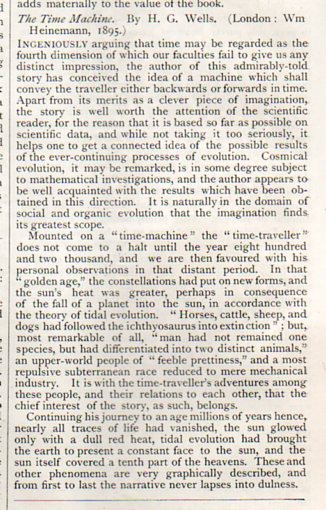ITEM: [Wells H.G. ] Review of Wells' The Time Machine in Nature, 18 July 1895. We offer the issue for the week (pp 265-188, plus 8pp advertisements numbered pp xc-xcvi), removed from a larger bound volume, complete with the scarce outer wrappers. Provenance: Smithsonian Astrophysical Obervatory Library, via the Library of Congress. Very nice copy. Very good condition. SOLD
Nature's editors says of the book:
"...apart from its merits as a clever piece of imagination, the story is well worth the attention of the scientific reader, for the reason that it is based as far as possible on scientific data..."
"It is naturally in he domain of social and organic evolution that the imagination finds its greatest scope."
"From first to last the narrative never lapses into dullness."
And so Wells--who had cleaned up and rewritten an earlier version of thi sbook from 1885--received a happy review from one of the leading scientific magazines of the time. It is not because of a wide interest of Wells in the fourth dimension per se, but rather in rattling Victorian sniffy conceits of his day.

*Time as the fourth dimension is a concept not much older than Well's idea, one of the earliest publications of the idea appearing ten years earlier (and written anonymously by "S") in Nature. Charles Hinton, the person we most associate with the introduction of the fourth dimension (or at least so on a popular level) didn't really establish time as the fourth dimension. (Hinton led a colorful, or at least interesting life--he was a brilliant guy, and also a convicted bigamist who was married to George Boole's daughter, and creator of an automatic baseball pitching machine. His books on the fourth dimension certainly were influential, and in the estimation of Florence was a contributor to the ideas of the coming modern art movements of the 1890-1910 period.)
And there were certainly many who came before Wells on the subject of the fourth dimension (though not many on the subject of time as the fourth dimension): R.C. Archibald wrote on d'Alembert's (1754) use of time as a fourth dimension (in the Bulletin of the American Mathematical Society for May 1914); Cayley's "Analytical Geometry of n-Dimensions (Cambridge Mathematical Journal, 1843); Grassmann's Die Lineale aus Dehnungslehre (1844); Riemann's 1854 effort on curved space (translated in 1873 for Nature by W. Kingdom Clifford); Beltrami's introduction of the pseudosphere in 1868; J.J. Sylvester (again in Nature for 30 December 1869); Hermann von Helmholtz and his curvature for three-dimensional spaces; and Poincare's work in 1900, among others. There is a rich field of these efforts, beautifully investgated for the general reader by Linda Dalrmple Henderson in her classic The Fourth Dimension and Non-Euclidean Geometry in Modern Art (Princeton 1983).



Comments